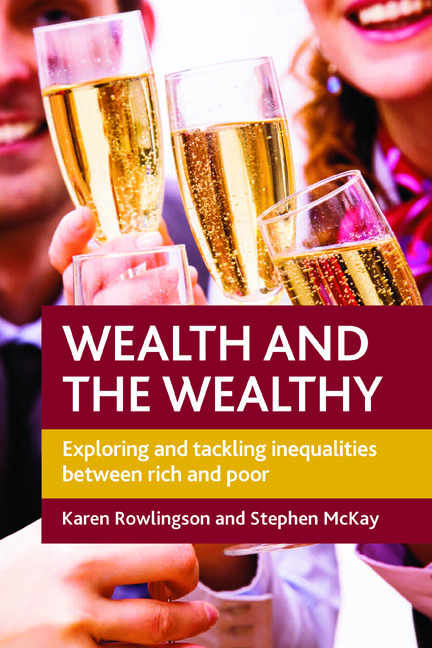Book contents
- Frontmatter
- Dedication
- Contents
- List of tables and figures
- Acknowledgements
- About the authors
- Introduction
- one Why wealth matters
- two Why the wealthy matter
- three What is wealth and who are the wealthy?
- four The distribution of wealth
- five The rich, the richer and the richest
- six Towards a comprehensive policy on assets
- seven Social policy and the wealthy
- Conclusions
- References
- Index
three - What is wealth and who are the wealthy?
Published online by Cambridge University Press: 01 September 2022
- Frontmatter
- Dedication
- Contents
- List of tables and figures
- Acknowledgements
- About the authors
- Introduction
- one Why wealth matters
- two Why the wealthy matter
- three What is wealth and who are the wealthy?
- four The distribution of wealth
- five The rich, the richer and the richest
- six Towards a comprehensive policy on assets
- seven Social policy and the wealthy
- Conclusions
- References
- Index
Summary
Introduction
In Chapters One and Two we argued that there were strong reasons for focusing our attention on wealth and the wealthy. In the course of those chapters we used the terms ‘wealth’ and ‘wealthy’ without too much discussion, but these terms are used in different ways at different times and there has been very little discussion among academics about what these mean, particularly compared with the extensive discussions of ‘poverty’ and low income. This chapter takes ‘wealth’ first and discusses how we might conceptualise, define and measure wealth. It then takes the same approach with ‘the wealthy’.
Conceptualising and defining wealth
As argued in the previous chapter, wealth has received relatively little attention from researchers. It is a term commonly used but not necessarily used in a consistent manner. So what is it? Our focus in this book is on wealth in the form of personal assets, but it is important to remember that there are other forms of wealth. For example, wealth can also be conceptualised as ‘capital’, and this term has been the subject of much debate. Various forms of capital have been identified at different times, for example, property and other forms of financial/ economic capital as well as human capital (skills and education), social capital (social networks and relationships) and cultural capital (symbolic goods including attitudes, language and habits) (Bourdieu, 1986; Putnam, 2000). All forms of capital play a role in relation to people's life chances and wellbeing, but the relative strength of each and the relationship between them is unclear. For example, economic capital is likely to play a major role in helping people increase their human capital, through paying for education and training. But cultural capital may also play a role if parental attitudes are such as to encourage children to focus on education. It is argued that social capital varies among different socioeconomic groups such that those from more middle-class backgrounds have ‘weak social ties’ across a large number of contacts which enables them to accumulate more ‘bridging capital’, and those from working-class backgrounds have ‘strong social ties’ which enables them to accumulate more ‘bonding social capital’ (Granovetter, 1973; Putnam, 2000).
- Type
- Chapter
- Information
- Wealth and the WealthyExploring and Tackling Inequalities between Rich and Poor, pp. 53 - 80Publisher: Bristol University PressPrint publication year: 2011



